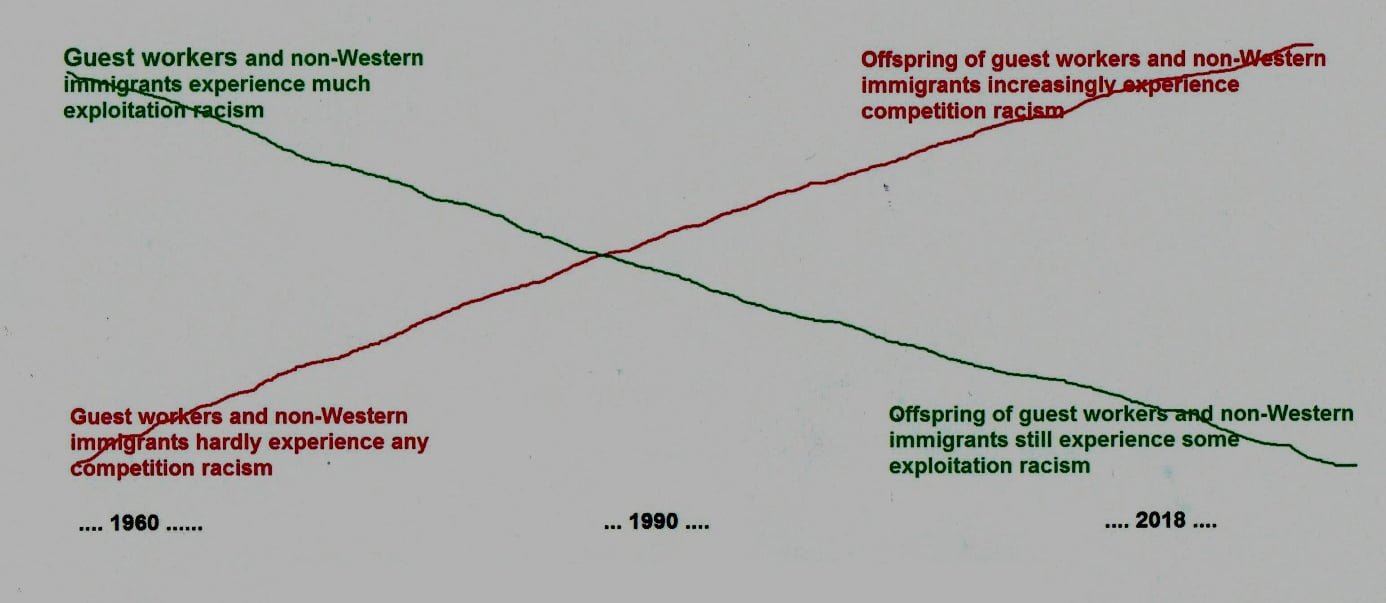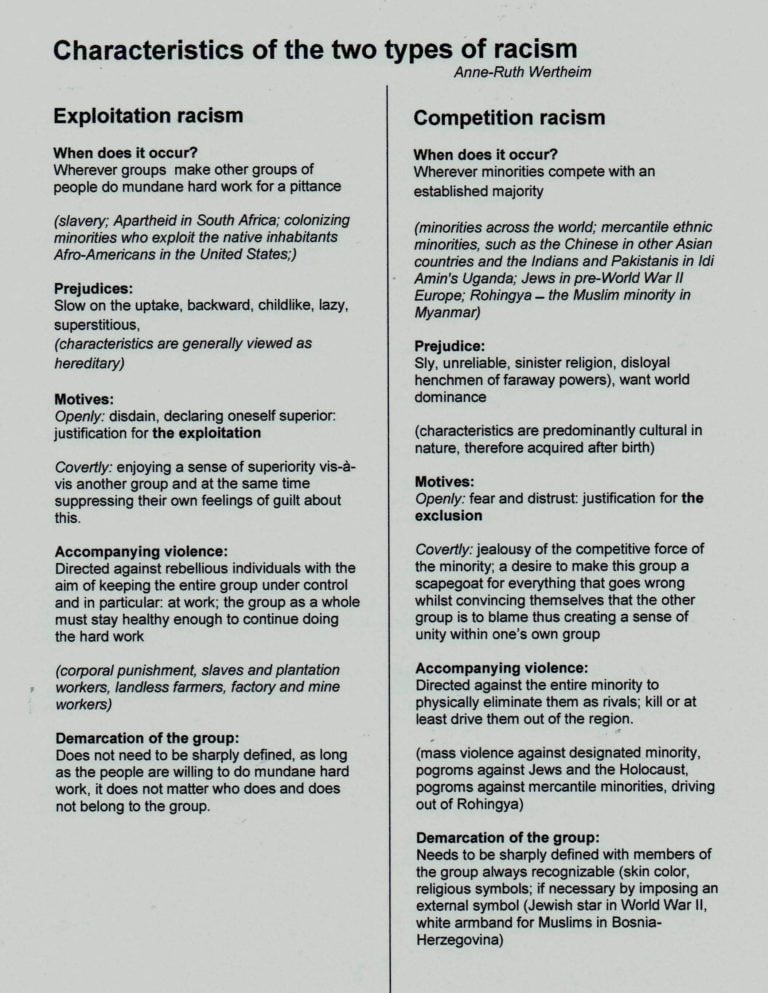Anne-Ruth Wertheim
Racism unraveled – how it works and how its guise is changingeled – how it works and how its guise is changing
In addition to racism in our parts predominantly taking the guise of Islamophobia in recent decades, now all those moldy myths about differences in IQ between black and white people are being dusted off. Not that horror stories about Muslims have vanished or any other prejudices about minority groups.
Discussions still focus on who can and who cannot be called racist, while the question what of racism actually is is fobbed off with vague descriptions in the direction of ‘believing population groups to be inferior’. Looking down on people is of course a terrible thing, but – although it is hardly ever talked about – jealousy is also at play. In the same way as what actually prompts people to utter their prejudices is seldom discussed. After all it is not just about what they say, it is mainly about what they prefer to keep to themselves. It is a dire necessity to see through the mechanisms at work, if for no other reason than to combat racism in such a way that racist violence does not break out in the future.
By unravelling these mechanisms, we make it possible to answer complicated questions. Questions such as: why are dark-skinned people who do important work in society initially belittled, only then to be criticized when they push ahead? Why are the offspring of guest workers and people from the former Dutch colonies put at a disadvantage when they compete in the labor market – often with a reference to habits which are attributed to the countries of their forefathers? Why after all these years is proportional representation in the media grossly lacking of people with a migration background? Why are politicians with a migration background continually pinned down on matters specifically concerning what people call ‘their community
’, when they try to tackle issues which affect the whole of society? And why are they labelled disloyal when they set up their own party after established parties fail to offer them enough opportunities? And finally why is it that racism has not declined, now that so many people with a migration background have reached prominent positions in government, politics and all other societal domains, such as film, music, cabaret, architecture, sport, medicine, literature, journalism, law and ICT?
Racism is a hodgepodge
Racism is a hodgepodge to start with comprising two components: exploitation racism and competition racism. And to make it even more complicated – the proportion of each of these two components in racism as a whole is also shifting as time progresses. This shifting is an intriguing phenomenon, see illustration: How the guise of prevalent racism is changing as time progresses.

The distinction between the two types of racism comes from my father, a sociologist who specialized in south-east Asia Wim F.Wertheim. As a child, he experienced what it
was like to be discriminated against as a Jew and as an adult in the colonial Dutch East Indies, he was struck by two totally distinct phenomena. He saw how the Indonesian population was exploited by means of the use of derogatory qualifications, whilst the Chinese mercantile minority was exposed to a form of racism which was strikingly similar to the anti-Semitism he knew from Europe. He named the first type exploitation racism and the second competition racism and described them in his academic work. Later I further developed these differences and integrated them into a chart in order to turn over in one’s mind the reasoning, see illustration: Characteristics of the two types of racism. The two types differ in the following ways: the population at which they are targeted, the prejudices which accompany them, the motivation behind the prejudices, and the kind of violence which goes with it.
Exploitation and competition racism
Exploitation and competition racism target two totally different groups and there is a direct connection with the work they do and their economic position. Consequently, there is a difference between the kind of prejudices which are brought into circulation: disparaging or fearsome in nature. The enslaved, the black population of South Africa, the original inhabitants of colonized countries and Afro-Americans in the US were supposed to have a low IQ ‘by nature’ and were considered lazy and childlike. And therefore mundane hard labour was the only thing they were capable of and supposedly what they preferred.
Stupid and lazy was the very last thing that would be used to describe the Chinese mercantile minority in Indonesia, they were said to be sly and untrustworthy. Besides they were henchmen for big scary China, which strove for world dominance. Jews were also said to be cunning, disloyal to the countries where they lived and hungry for world power. As proof a falsified document from bygone times was conjured up in which mysterious men were said to have used words to this effect. And now it is the turn of Muslims. To support the idea that they are not to be trusted and are disloyal, rumors are spread that they are controlled by the long arm of their mother country, with references to their dual nationality. And if that does not suffice, their holy scriptures are cited selectively so that they can be accused of wanting to establish Sharia law worldwide.
Motives behind racist prejudices, what do people prefer to keep to themselves?
The motives behind the prejudices circulating about certain population groups are wholly in line with what needs to be justified: in the first case exploitation, and in the second exclusion. But when asked about their motives is what people declare, what they actually say, really the only thing driving them? Could there be something else, which they would rather keep quiet?
People who look down on another population group will probably not readily admit how good it feels to raise themselves above others. In cultures and faith communities in which the dominating norm is that all people are equal, and this applies to by far the most, you may expect such a sense of superiority to be coupled with feelings of shame and/or guilt. All the more reason to find even more evidence that the other group is, in actual fact, inferior.
A similar phenomenon could be at play when there is a fear of a minority’s competitive power. People will probably not be inclined to reveal their envy, because in a capitalist society like ours there is effectively a taboo on jealousy. Moreover, it makes much more sense to keep it a secret when you think that a group is doing well, otherwise you might weaken your own group’s competitive position. It’s therefore a hundred times more profitable to state with great emphasis that the group is not to be trusted and is a great danger to society.
After all identifying a scapegoat for everything that goes wrong in society is generally not something to be proud about. People who do so will probably not like to acknowledge how they enjoy sharing the conviction with like-minded people around them that the cause of all misery should really be sought in the scapegoat group.

Shift in the proportions of exploitation- and competition racism in racism as a whole
When I carried out research into adult education in the 1990s, I observed a noteworthy phenomenon. My task was to register signs of racism during Dutch lessons for Dutch-speaking adults who had hardly attended school and during Dutch lessons as a second language for migrants. I discovered – to some extent concealed in expressions and gestures – that both disdain/self-conceit (exploitation racism) and jealousy, distrust and fear (competition racism) occurred. As a result, I wondered whether this mixture only occurred at this moment in this setting, or whether prevailing racism was perhaps changing. I put forward the hypothesis that a shift is taking place here in Europe, and therefore also in the Netherlands, from exploitation racism towards competition racism.
In the meantime almost 30 years have passed and my hypothesis has not only turned out to be true, this phenomenon is still prevalent. The first guest workers and non-Western immigrants from the colonies predominantly suffered from the old, familiar colonial exploitation racism – they were looked upon with disdain. This disdain was still going strong in the 1990s and continues today. Disparaging prejudices are still targeted at people of color, and people who come from regions which are considered to be less developed are also seen in this light.
However, the more their children and grandchildren were able to compete, the more additional prejudices were circulated which belong to competition racism. More and more offspring from guest workers managed – often after overcoming severe underestimation and opposition – to complete their studies and gain a foothold in attractive positions in the labor market, making them rivals to the established population – especially those with good qualifications. Among the descendants of the guest workers it were particularly the Muslims who were a welcome target for the frightful prejudices which accompany competition racism. While the children and grandchildren of inhabitants from former colonies also received the same treatment, the more they became formidable rivals – in addition to the usual exploitation racism, which never disappeared and which has been on the increase in recent years. And now we have the non-Western refugees as well. They are said to steal jobs and get homes unfairly as well as being dangerous and not belonging here.
I hope and expect that people who want to halt this fatal development will be better equipped to do so when they are able to get to the bottom of the mechanisms at play.